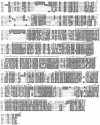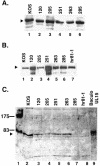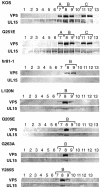Point mutations in exon I of the herpes simplex virus putative terminase subunit, UL15, indicate that the most conserved residues are essential for cleavage and packaging
- PMID: 12915573
- PMCID: PMC187393
- DOI: 10.1128/jvi.77.17.9613-9621.2003
Point mutations in exon I of the herpes simplex virus putative terminase subunit, UL15, indicate that the most conserved residues are essential for cleavage and packaging
Abstract
The herpes simplex virus UL15 and UL28 genes are believed to encode two subunits of the terminase involved in cleavage and packaging of viral genomes. Analysis of the UL15 protein sequence and its herpesvirus homologues revealed the presence of 20 conserved regions. Twelve of the twenty regions conserved among herpesviruses are also conserved in terminases from DNA bacteriophage. Point mutations in UL15 were designed in four conserved regions: L120N (CR1), Q205E (CR2), Q251E (CR3), G263A (CR3), and Y285S (CR4). Transfection experiments indicated that each mutant gene could produce stable UL15 protein at wild-type levels; however, only one mutant (Q251E) was able to complement the UL15-null virus. Each mutation was introduced into the viral genome by marker transfer, and all mutants except Q251E were unable to form plaques on Vero cells. Furthermore, failure to form plaques on Vero cells correlated with a defect in cleavage and packaging. Immunofluorescence experiments indicated that in cells infected with all mutant viruses the UL15 protein could be detected and was found to localize to replication compartments. Although wild-type and mutant Q251E were able to produce A, B, and C capsids, the rest of the mutants were only able to produce B capsids, a finding consistent with their defects in cleavage and packaging. In addition, all mutant UL15 proteins retained their ability to interact with B capsids. Therefore, amino acid residues 120, 205, 263, and 285 are essential for the cleavage and packaging process rather than for association with capsids or localization to replication compartments.
Figures






Similar articles
-
Herpes simplex virus type 1 cleavage and packaging proteins UL15 and UL28 are associated with B but not C capsids during packaging.J Virol. 1998 Sep;72(9):7428-39. doi: 10.1128/JVI.72.9.7428-7439.1998. J Virol. 1998. PMID: 9696839 Free PMC article.
-
Herpes simplex virus type 1 portal protein UL6 interacts with the putative terminase subunits UL15 and UL28.J Virol. 2003 Jun;77(11):6351-8. doi: 10.1128/jvi.77.11.6351-6358.2003. J Virol. 2003. PMID: 12743292 Free PMC article.
-
Linker insertion mutations in the herpes simplex virus type 1 UL28 gene: effects on UL28 interaction with UL15 and UL33 and identification of a second-site mutation in the UL15 gene that suppresses a lethal UL28 mutation.J Virol. 2006 Dec;80(24):12312-23. doi: 10.1128/JVI.01766-06. Epub 2006 Oct 11. J Virol. 2006. PMID: 17035316 Free PMC article.
-
Genetic analysis of the UL 15 gene locus for the putative terminase of herpes simplex virus type 1.Virology. 1998 Mar 30;243(1):32-44. doi: 10.1006/viro.1998.9041. Virology. 1998. PMID: 9527913
-
The Terminase Complex of Each Human Herpesvirus.Biol Pharm Bull. 2024;47(5):912-916. doi: 10.1248/bpb.b23-00717. Biol Pharm Bull. 2024. PMID: 38692868 Review.
Cited by
-
Identification of a spliced gene from duck enteritis virus encoding a protein homologous to UL15 of herpes simplex virus 1.Virol J. 2011 Apr 6;8:156. doi: 10.1186/1743-422X-8-156. Virol J. 2011. PMID: 21466705 Free PMC article.
-
Current and potential treatments for ubiquitous but neglected herpesvirus infections.Chem Rev. 2014 Nov 26;114(22):11382-412. doi: 10.1021/cr500255e. Epub 2014 Oct 2. Chem Rev. 2014. PMID: 25275644 Free PMC article. Review. No abstract available.
-
Exploring the Potential of HIV Integrase Inhibitors as Therapeutic Agents Against HSV and HCMV: A Molecular Docking Study.J Exp Pharmacol. 2025 Jul 23;17:507-518. doi: 10.2147/JEP.S524226. eCollection 2025. J Exp Pharmacol. 2025. PMID: 40727394 Free PMC article.
-
Identification of candidate gammaherpesvirus 68 genes required for virus replication by signature-tagged transposon mutagenesis.J Virol. 2004 Oct;78(19):10282-90. doi: 10.1128/JVI.78.19.10282-10290.2004. J Virol. 2004. PMID: 15367594 Free PMC article.
-
The generalized transducing Salmonella bacteriophage ES18: complete genome sequence and DNA packaging strategy.J Bacteriol. 2005 Feb;187(3):1091-104. doi: 10.1128/JB.187.3.1091-1104.2005. J Bacteriol. 2005. PMID: 15659686 Free PMC article.
References
-
- Abbotts, A. P., V. G. Preston, M. Hughes, A. H. Patel, and N. D. Stow. 2000. Interaction of the herpes simplex virus type 1 packaging protein UL15 with full-length and deleted forms of the UL28 protein. J. Gen. Virol. 81:2999-3009. - PubMed
-
- al-Kobaisi, M. F., F. J. Rizon, I. McDougall, and V. G. Preston. 1991. The herpes simplex virus UL33 gene product is required for the assembly of full capsids. J. Virol. 180:380-388. - PubMed
Publication types
MeSH terms
Substances
Grants and funding
LinkOut - more resources
Full Text Sources

